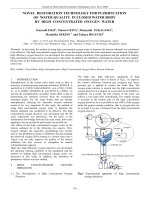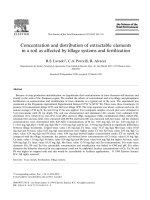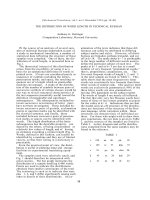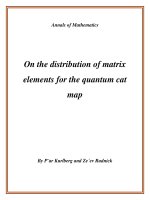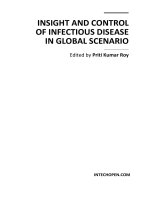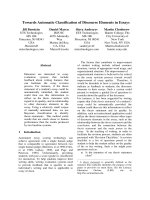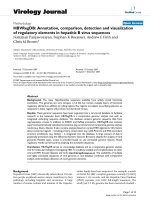Concentration and distribution of extractable elements in soil as affected by tillage systems and fertil
Bạn đang xem bản rút gọn của tài liệu. Xem và tải ngay bản đầy đủ của tài liệu tại đây (175.68 KB, 7 trang )
Ž.
The Science of the Total Environment 232 1999 185᎐ 191
Concentration and distribution of extractable elements
in a soil as affected by tillage systems and fertilization
R.S. Lavado
U
, C.A. Porcelli, R. Alvarez
Departamento de Suelos, Facultad de Agronomıa, Uni¨ersidad de Buenos Aires, A¨. San Martın 4453, 1417 Buenos Aires,
´´
Argentina
Received 20 September 1998; accepted 21 March 1999
Abstract
Because of crop production intensification, we hypothesize that concentrations of trace elements will increase and
stratify in the soils of the Pampean region. We studied the effects of conventional and zero-tillage and phosphorus
fertilization on concentration and stratification of trace elements in a typical soil of the area. The experiment was
Ž. Ž.
conducted at the Pergamino Agricultural Experimental Station 33Њ56Ј S; 60Њ34Ј W . There were three treatments: i
Ž. Ž. Ž. Ž.
pasture; ii conventional tillage CT ; and iii zero tillage ZT . The crop sequence was wheat, soybean and corn. An
annual average of 90 kg Nrha and 18 kg Prha was applied. Two composite samples of each plot were obtained in
Ž. Ž . Ž .
5-cm increments until 20 cm depth. The soil was characterized and aluminum Al , arsenic As , cadmium Cd ,
Ž. Ž . Ž. Ž. Ž . Ž . Ž . Ž.
chromium Cr , cobalt Co , iron Fe , lead Pb , mercury Hg , manganese Mn , molybdenum Mo , nickel Ni ,
Ž. Ž . Ž.
selenium Se and zinc Zn , were extracted with DTPA and boron B was extracted with hot water. All the element
Ž.Ž.
concentrations were determined with ICP-AES. Concentrations of B av. 0.48 mgrkg , Cd av. 0.20 mgrkg Cr
Ž.Ž .Ž.Ž .
-0.01 mgrkg , Hg -0.005 mgrkg , Mo -0.01 mgrkg , and Se av. 3.33 mgrkg showed no significant differences
Ž.Ž .Ž
between tillage treatments. Copper max. value 1.46 mgrkg , Fe max. value 76.27 mgrkg , Mn max. value 10.48
.Ž . Ž .
mgrkg and Ni max. value 0.65 mgrkg concentrations were higher under CT but Zn max. value 2.03 mgrkg , Co
Ž.Ž.
max. value 0.34 mgrkg and Pb max. value 0.94 mgrkg showed higher concentration under ZT on topsoil. As
Ž.
compared with the tillage treatments, the pasture soil showed lower concentrations of Co max. value 0.16 mgrkg ,
Ž.Ž.Ž.Ž
Cu max. value 1.10 mgrkg , Ni max. value 0.36 mgrkg and Pb max. value 0.66 mgrkg but higher As max. value
.Ž . Ž .
0.09 mgrkg , Fe max. value 83.55 mgrkg , Mn max. value 13.78 mgrkg and Zn concentrations. For some trace
Ž.
elements Co, Pb and Zn the extractable concentration and stratification was linked to OM and pH. For other
elements the behavior observed in our experiment could not be explained. Surface concentrations of Co, Cu, Ni and
Pb was higher in cropped soils and this would be accreditable to fertilizer applications. ᮊ 1999 Elsevier Science
B.V. All rights reserved.
Keywords: Trace metals; Fertilization; Tillage systems
U
Corresponding author. Fax: q54-11-4524-8076.
Ž.
E-mail address: R.S. Lavado
0048-9697r99r$ - see front matter ᮊ 1999 Elsevier Science B.V. All rights reserved.
Ž.
PII: S 0 0 4 8 - 9 6 9 7 9 9 0 0 0 9 5 - 9
()
R.S. La¨ado et al. r The Science of the Total En¨ironment 232 1999 185᎐191186
1. 1. Introduction
It has been widely known for more than 30
years that soil organic matter and nutrients usu-
ally stratify when soils are not plowed for a long
Ž.Ž .
time i.e. zero-tillage Singh et al. 1966 . This
stratification process might increase nutrients
Ž
availability and crop absorption Singh et al. 1966;
.
Hargrove 1985 . The two main causes of stratifi-
cation are crop residues accumulation on topsoil
Ž.
and fertilizers application Blevins et al. 1983 .
Ž.
Recently, Scheiner and Lavado 1998 showed
that fertilization is the most important factor for
phosphorus stratification. For some micronutri-
Ž.
ents Cu, Fe, Mn, Zn the stratification was also
Ž.
established Hargrove, 1985; Edwards et al., 1992
but the behavior of other elements is far less
Ž.
known. Oliver et al. 1993 recorded higher Cd
concentrations in wheat under zero tillage, as
compared with minimum or conventional tillage
Ž.
but Cd concentration in soils EDTA extraction
did not show apparent differences under zero-
minimum or conventional tillage.
Trace elements are normally found in phos-
Ž
phate fertilizers Charter et al. 1995; Todorova
.
and Dombalov 1995 and fertilization for long
Ž
periods increases their concentration in soils He
.
and Singh, 1993b; Taylor, 1997 . These elements
are absorbed by plants and some are contami-
nants, which might become a risk for the environ-
ment and health. Among these elements Cd, Cr,
Ni, Pb and the micronutrients Cu and Zn can be
Ž
mentioned Charter et al., 1995; Jeng and Slingh,
.
1995 . The bioavailability of these elements de-
pends upon their chemical forms in soils, which is
related to clay content and mineralogy, the or-
ganic matter type and content, pH and Eh
Ž
changes, among other factors Fergusson, 1991;
.
Lee et al., 1997 . Several authors have found a
direct relationship between organic matter or Al
concentration and extractable trace element con-
Ž.
centration i.e. Lee et al. 1997 . Extraction with
DTPA or EDTA are used as a measure of
Ž.
bioavailability Fergusson, 1991 .
The agricultural production on the very fertile
Ž.
soils of the Pampean region Argentina were
carried out with conventional tillage and without
fertilizer from its start, 100r120 years ago. From
the last years, both the use of reduced tillage
systems, including ZT, and phosphate fertilization
are increasing dramatically. The widespread use
of this technology along the time will affect the
soil properties of the region. Among them, we
hypothesize that concentrations of trace elements
will increase and stratify in those soils. However,
as a consequence of the recent introduction of
zero tillage and the lack of fertilization history,
there are no old field experiments in the region
combining tillage and fertilization. With this limi-
tation, our objective was to study the effects of
Ž
two extreme tillage systems conventional and
.
zero-tillage and phosphorus fertilization on con-
centration and stratification of extractable ele-
ments in a representative soil of the Rolling
Pampa, the most productive area of the Pampas.
2. Materials and methods
We worked in an experiment performed at the
Agricultural Experimental Station located in Per-
Ž.
gamino 33Њ56Ј S; 60Њ34Ј W . The soil is a Per-
gamino Series, fine illitic thermic Typic Argiudoll
Ž.
Table 1 . In 1979 three soil treatments started:
Ž.
i a pasture of Festuca arundinacea, which never
Ž. Ž .
was fertilized; ii conventional tillage CT which
consisted of moldboard-plowing the soil up to 15
cm depth, 2᎐ 3 months before sowing, followed by
Ž. Ž .
a vibrocultivator; iii zero tillage ZT , where the
soil was cropped under direct drilling. The experi-
ment had a randomized block design, with two
replications of each treatment. Plot size was 7=
50 m. The crop sequence was wheat and soybean
in one agricultural cycle and corn in the following
cycle. The plots were fertilized annually, averag-
ing an application of 90 kg Nrha and 18 kg Prha,
as urea and triple superphosphate, respectively.
In autumn 1997, two composite samples from
each plot were obtained by mixing 10 subsamples
collected at random. These samples were ob-
tained from the following layers: 0᎐5, 5᎐ 10, 10᎐15
and 15᎐ 20 cm.
All soil samples were air dried and grounded.
The following soil properties were analyzed: or-
Ž.
ganic matter OM by dry combustion; pH in a
1:1 soilrwater ratio; exchangeable cations by ex-
()
R.S. La¨ado et al. r The Science of the Total En¨ironment 232 1999 185᎐191 187
Table 1
a
Concentration and distribution in depth of organic matter, macronutrients, and other soil components
Ž.
Treatment Depth cm
0᎐ 55᎐10 10᎐ 15 15᎐ 20
OM ZT 3.87 bA 2.73 bB 2.83 bB 2.63 bB
% CT 2.70 cA 2.70 bA 2.80 bA 2.53 bA
Past 6.60 aA 4.10 aB 3.03 bC 2.80 bC
Exchang. ZT 17.67 aA 7.33 bB 7.67aB 6.33 aB
P CT 21.50 aA 17.50 aB 11.50 aC 8.03 aC
ppm Past 13.25 bA 9.75 bB 8.75 aB 8.50 aB
pH ZT 5.10 aA 5.70 aA 5.83 aB 5.93 aB
CT 5.77 bA 5.80 aA 5.80 aA 5.93 aA
Past 5.98 bA 6.10 aA 6.18 aA 6.28 aB
Exchang. ZT 7.35 aA 9.09 aA 9.36 aB 10.14 aB
b
Ca CT 8.53 aA 8.77 aA 8.90 aA 9.41 aA
Past 7.59 aA 8.36 aA 9.10 aA 9.41 aA
Exchang. ZT 1.16 aA 1.40 aB 1.41 aB 1.67 aB
Mg CT 1.49 aA 1.48 aA 1.52 aA 1.81 aB
Past 1.95 bA 1.80 aA 1.64 cA 1.44 aB
Exchang. ZT 0.95 aA 0.93 aA 0.91 aA 0.94 aA
K CT 1.05 bA 1.09 aA 1.06 aA 1.10 aA
Past 1.41 bA 1.61 bA 1.68 bA 1.53 bA
Extract. ZT 7.54 aA 8.07 aA 3.46 aB 3.14 aB
Al CT 4.81 bA 5.51 bA 3.36 aA 3.97 aA
ppm Past 2.30 bA 5.00 bB 2.56 aB 2.48 aB
a
ZT, zero tillage, fertilized; CT, conventional tillage, fertilized; past, pasture, not fertilized. Different small letters mean
Ž. Ž.
significant differences P - 0.05 among treatments. Different capital letters mean significant differences P-0.05 among depths.
b
Exchangeable cations: meq.r100 g.
traction with ammonium acetate followed by
atomic absorption determination; available phos-
phorus by the Bray᎐ Kurtz No. 1 method. Trace
elements: As, Cd, Co, Cr, Fe, Pb, Hg, Mn, Mo,
Ni, Se, Zn, and Al were extracted with DTPA and
determined with ICP-AES; B was extracted with
hot water and determined with ICP-AES. The
analytical procedures were standardized using
reference material. In all cases, standard proce-
Ž.
dures described by Sparks et al. 1996 were used.
The experiment was a factorial with three
treatments four depths and two replications. All
data were subjected to ANOVA, and when sig-
Ž.
nificant differences P - 0.05 were detected,
Duncan’s test was performed to separate means.
3. Results and discussion
Table 1 shows the stratification and changes in
concentration of organic matter, macronutrients
and other soil components under the influence of
the treatments. This behavior resembled that one
Ž
previously found in the area i.e. Alvarez et al.
.
1995 and elsewhere. Among trace elements, B
Ž.Ž
0.42᎐ 0.53 mgrkg , Cr in all cases F 0.01
.Ž . Ž
mgrkg , Hg in all cases -0.005 mgrkg , Mo in
.Ž
all cases F 0.01 mgrkg , and Se 3.09᎐ 3.57
.
mgrkg exhibited no differences in concentra-
tions among treatments or depths. Cadmium, with
concentrations between 0.17 and 0.23 mgrkg,
showed no differences among treatments but dif-
ferences in depths. The highest Cd concentration
was found on top soil. The remainder trace ele-
ments were affected by the treatments either in
their concentration or in their depth distribution.
Data are shown in Table 2 and Figs. 1᎐3.
Iron and Mn concentrations were higher under
CT but decreased significantly in depth. Zn strati-
fied significantly in both treatments but on topsoil
Ž.
0᎐5 cm showed higher concentration under ZT
and from 5 to 25-cm depth their concentration
()
R.S. La¨ado et al. r The Science of the Total En¨ironment 232 1999 185᎐191188
Table 2
a
Ž.
Concentration and distribution in depth of arsenic, copper, iron, lead and manganese mgrkg
Ž.
Element Treatment Depth cm
0᎐ 55᎐10 10᎐ 15 15᎐ 20
As ZT 0.058 aA 0.058 aA 0.059 aA 0.058 aA
CT 0.059 aA 0.058 aA 0.059 aA 0.060 aA
Past 0.087 bA 0.087 bA 0.091 bA 0.091 bA
Pb ZT 0.943 aA 0.703 aB 0.667 aB 0.650 aB
CT 0.737 bB 0.953 aB 0.677 cB 0.687 aB
Past 0.665 cB 0.668 aB 0.668 aB 0.725 aB
Cu ZT 1.255 aA 1.423 aA 1.433 aA 1.440 aA
CT 1.464 bA 1.481 aA 1.553 aA 1.543 aA
Past 1.100 cA 1.425 aA 1.575 aA 1.400 aA
Fe ZT 71.457 aA 67.210 aA 65.563 aA 60.233 aB
CT 76.267 bA 78.000 bA 79.560 bA 72.843 bA
Past 83.550 cA 82.250 bA 59.875 aB 54.725 aB
Mn ZT 9.507 aA 9.820 aA 9.860 aA 9.247 aB
CT 10.500 bA 10.480 aA 10.807 aA 10.167 aB
Past 13.775 cA 10.225 aB 7.850 bC 7.050 bC
a
ZT, zero tillage, fertilized; CT, conventional tillage, fertilized; Past, pasture, not fertilized. Different small letters means
Ž. Ž.
significant differences P- 0.05 among treatments. Different capital letters means significant differences P- 0.05 among depths.
was significantly higher under CT. Cu concentra-
tion was significantly higher under CT and showed
Ž.
no trends to stratify. Hargrove 1985 found that
in an Ultisol, Mn and Zn accumulated on topsoil
under ZT. Meanwhile, Cu concentrations were
not affected by different tillage systems and Fe
Ž. Ž. Ž .
Fig. 1. Concentration and distribution in depth of zinc in zero-tillage ZT , conventional tillage CT and pasture Past . Different
Ž.
small letters mean significant differences P - 0.05 among treatments. Different capital letters mean significant differences
Ž.
P-0.05 among depths.
()
R.S. La¨ado et al. r The Science of the Total En¨ironment 232 1999 185᎐191 189
Ž. Ž. Ž .
Fig. 2. Concentration and distribution in depth of cobalt in zero-tillage ZT , conventional tillage CT and pasture Past . Different
Ž.
small letters mean significant differences P - 0.05 among treatments. Different capital letters mean significant differences
Ž.
P-0.05 among depths.
concentration decreased under ZT. Edwards et
Ž.
al. 1992 found that Cu was not affected by
tillage or rotations. From the remainder trace
elements, Co and Pb showed significant higher
concentrations on top soil under ZT, but arsenic
and nickel did not show differences related to
tillage systems. Arsenic did not show stratification
but the other trace elements showed a significant
decrease downwards.
Ž.
Shuman and Hargrove 1985 found that the
organic matter accumulation and changes in soil
pH affected the micronutrients distribution and
that Zn was very sensitive to pH changes. Ed-
Ž.
wards et al. 1992 found high lineal relationships
between OM and Mn and Zn concentrations, but
those relations improved when pH was included
Ž.
in the equations. Carter and Gupta 1997 found
that the tillage systems affected the Cu, Mn, Mo
and Zn crop absorption, because of the changes
Ž.
in soil pH. He and Singh 1993a , on the other
hand, did not find any correlation between OM
and DTPA extracted Cd, under field conditions,
but they found a significant relation between OM
and DTPA extracted Cd, under controlled condi-
Ž.
tions. As a general view, Fergusson 1991 pointed
out that levels of extractable trace elements not
always can be explained as a function of changes
in soil properties. This was the case in this study
for B, Cd, Cr, Hg, Mo and Se. Cobalt, Fe and Mn
showed higher concentrations on top soil under
CT, with slightly higher pH values and lower OM
and Al. Only the higher contents of Co, Pb and
Zn in top soil under ZT were related to higher
OM and Al contents and lower pH in those soils.
The comparison between both cropped treat-
ments and the pasture showed that in the latter
there were lower values of Co, Cu and Pb concen-
trations on top soil and Ni concentrations lower
in all depths. This can be attributed to the enrich-
ment in trace elements in cropped soils from
phosphate fertilizers. The values of Fe, Mn and
Zn were higher in the pasture soil and another
process must be taken into account: the nutrient
uptake by the non-fertilized crop and the exporta-
tion by the harvest. Arsenic showed a unique
behavior: higher concentrations in all depths un-
()
R.S. La¨ado et al. r The Science of the Total En¨ironment 232 1999 185᎐191190
Ž. Ž. Ž .
Fig. 3. Concentration and distribution in depth of nickel in zero-tillage ZT , conventional tillage CT and pasture Past . Different
Ž.
small letters mean significant differences P - 0.05 among treatments. Different capital letters mean significant differences
Ž.
P-0.05 among depths.
der pasture as compared with cropped soils. Per-
haps a remainder of old arsenate, as insecticide,
applied to the pasture.
4. Conclusion
The DTPA extractable trace element concen-
trations are low in general and for some elements
they are around the detection limit. For some
Ž.
trace elements Co, Pb and Zn the extractable
concentration and stratification was linked to OM
and pH. For other elements the behavior observed
in our experiment could not be explained. Surface
concentrations of Co, Cu, Ni and Pb was higher
in cropped soils and this would be accreditable to
fertilizer applications.
Acknowledgements
The research was granted by the National Re-
Ž.
search Council of Argentina CONICET .
References
Alvarez R, Dıaz RA, Barbero N, Santanatoglia OJ, Blotta L.
´
Soil organic carbon, microbial biomass and CO ᎐ C produc-
2
tion from three tillage systems. Soil Tillage Res
1995;33:17᎐ 28.
Blevins RL, Thomas GW, Smith MS, Frye WW, Cornelius PL.
Changes in soil properties after 10 years non-tilled and
conventionally tilled corn. Soil Tillage Res 1983;3:135᎐ 146.
Carter MR, Gupta UC. Micronutrient concentration in barley
and soybean under minimum tillage on podzolic soils in a
cool climate. Acta Agric Scand Ser B 1997;47:7᎐ 13.
Charter R.A., Tabatabai M.A., Schafer J.W. Arsenic, molyb-
denum, selenium, and tungsten contents of fertilizers and
phosphate rocks. Commun Soil Sci Plant Anal
1995;26:17᎐ 18, 3051᎐ 3060.
Edwards JH, Wood CW, Thurlow DL, Ruf ME. Tillage and
crop rotation effects on fertility status of a Hapludult soil.
Soil Sci Soc Am J 1992;56:1577᎐ 1582.
Fergusson JE. The heavy elements, chemistry, environmental
impact and health effects. Oxford, UK: Pergamon Press,
1991:405.
Hargrove WL. Influence of tillage on nutrient uptake and
yield of corn. Agron J 1985;77:763᎐ 768.
He QB, Singh BR. Effect of organic matter on the distribu-
tion, extractability and uptake of cadmium in soils. J Soil
Sci 1993a;44:641᎐ 650.
He QB, Singh BR. Crop uptake of cadmium from phosphorus
()
R.S. La¨ado et al. r The Science of the Total En¨ironment 232 1999 185᎐191 191
fertilizer: I. Yield and cadmium content. Water Air Soil
Pollut 1993b;74:251᎐ 265.
Jeng AS, Slingh BR. Cadmium status of soils and plants from
a long-term fertility experiment in southeast Norway. Plant
Soil 1995;175:67᎐ 74.
Lee BD, Carter BJ, Basta NT, Weaver B. Factors influencing
heavy metal distribution in six Oklahoma benchmark soils.
Soil Sci Soc Am J 1997;61:218᎐223.
Oliver DP, Schultz JE, Tiller KG, Merry RH. The effect of
crop rotations and tillage practices on cadmium concentra-
tion in wheat grain. Aust J Agric Res 1993;44:1221᎐ 1234.
Scheiner JD, Lavado RS. The role of fertilization on phospho-
rus stratification in non tilled soils. Commun Soil Sci Plant
Anal 1998;29:2705᎐ 2711.
Shuman LM, Hargrove WL. Effect of tillage on the distribu-
tion of manganese, copper, iron, and zinc in soil fractions.
Soil Sci Soc Am J 1985;49:1117᎐ 1121.
Singh TA, Thomas GW, Moschler WW, Martens DC. Phos-
Ž.
phorus uptake by corn Zea mays L. under no-tillage and
conventional practices. Agron J 1966;58:147᎐ 148.
Sparks DL, Page AL, Helmke PA et al., editors. Methods of
soil analysis. Part 3. In: Chemical methods. 3rd ed. Madison,
Wisconsin, USA: ASA, 1996:1390.
Taylor MD. Accumulation of cadmium derived from fertilizers
in New Zealand soils. Sci Total Environ 1997;208:123᎐126.
Todorova EI, Dombalov IP. Production of phosphoric acid
with low content of impurities. Fert Res 1995;41:125᎐ 128.
